Since my last post I have acquired several new plants, specifically three Aglaonemas. So, this post is going to be about Aglaonemas. As I mentioned in the last post, I have lots of favorite plants, but genus-wide, Aglaonemas are my favorite. They are a very common foliage plant in office buildings, malls, etc. – commonly called “Chinese Evergreen,” “Silver King,” or “Silver Queen.” It is a very low maintenance plant that grows well in a range of lighting conditions and watering. For this reason, many different varieties have been cultivated that have varying silvery variegations. The goal of these cultivars is to create a more showy, unique look, with the same hardiness as the natural occurring species. Here’s what I know about them:
Division: Magnoliophyta
Class: Liliopsida
SubClass: base monocots
Order: Alismatales
SubOrder:
Family: Araceae
SubFamily: Aroideae
Tribe: Aglaonemateae
I have compiled a list (nomenclature) with as many different species and cultivars as I could find.
Two of the species I found recently were of average size plants (about 8 inches tall) – of species that I had not seen before.
My third find was another A. species I had not seen before(below), but this one was monstrous - and blooming! Aglaonemas are not known for their inflorescence (bloomage), so I was surprised to see fairly elegant, simple white blooms on this plant that closely resemble a peace lily (spathiphyllum). I have not been able to get a proper species identification on this one yet.
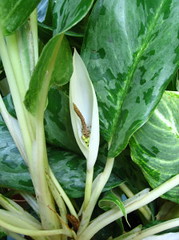
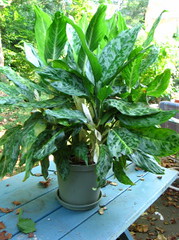
A couple of my Anubias plants have also produced nice blooms in my 29 gallon planted aquarium, that resemble the bloom of a peace lily.
Back to my new species of Aglaonemas... I have another new species (below) without an id. It looks a bit like a variety of A. pictum. The leaves have three shades of green and the plant appears much darker than most Aglaonema species, due to its lack of silver coloring.
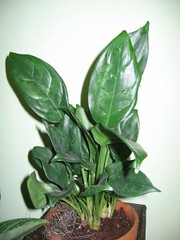
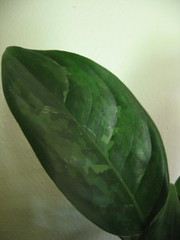
My other new Aglaonema (below) is also unidentified. It has fairly large leaves that are predominantly silver, with two shades of green.
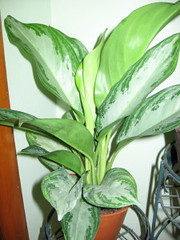
And here are some pictures of my other Aglaonemas:
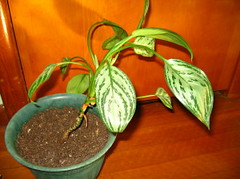
A. commutatum (above): This was my first Aglaonema, given to me by my mom. It grows on a long, spindly stalk, much less like a rosette, compared with my others. It was in a jar of water for a long period of time (at least a year) rooting, before it was planted and given to me.
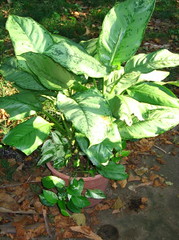
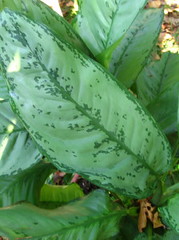
A. 'B.J. Freeman' (above): This one is a very large cultivar and has survived an attack by Pippa, my dog. She ate several of the large leaves, leaving behind the spines. It had a rough time for a couple weeks after that, but has recovered pretty nicely.
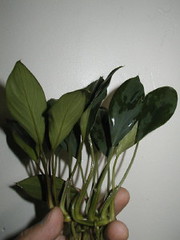
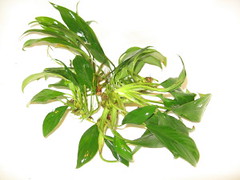
A. minima: This plant (above) is claimed to be an Aglaonema. I'm not sure that it is; I'm not sure that it isn't. I am sure that it doesn't look much like the pictures of the plant before I ordered it (above-top)! I have 5 of these living in my 29 gallon aquarium, where their leaves turn yellow and mushy quite often, but are replaced by new growth.
[Update 2017: I'm pretty sure this is an Anubias.]
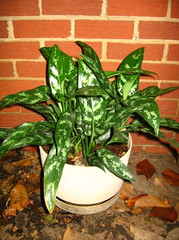
A. 'Maria' (above): Last is my favorite - Maria. It seems to be the most striking of all Aglaonema I have seen. And it does help that this is my fullest Aglaonema.
As far as I know, there are about 20 naturally-occurring legitimate species and probably around 150 cultivars. Some of them are so similar that I don’t know how they can be correctly identified. Just in case anyone is interested, I like to post pictures of my unidentifiables plants to the “Name that plant” forum (http://forums2.gardenweb.com/forums/namegal/). There are lots of knowledgeable people who regularly check the forum and identify plants for people. Most Aglaonemas have cool silvery splotches of some sorts. But there are a couple that are not very showy, and to me, not very interesting (A. modestum). Some cool Aglaonemas that I don’t have include A. costatum, A. ‘Black Lance’, A. ‘White Lance’, and A. pictum ‘tricolor’.
Division: Magnoliophyta
Class: Liliopsida
SubClass: base monocots
Order: Alismatales
SubOrder:
Family: Araceae
SubFamily: Aroideae
Tribe: Aglaonemateae
I have compiled a list (nomenclature) with as many different species and cultivars as I could find.
Two of the species I found recently were of average size plants (about 8 inches tall) – of species that I had not seen before.
My third find was another A. species I had not seen before(below), but this one was monstrous - and blooming! Aglaonemas are not known for their inflorescence (bloomage), so I was surprised to see fairly elegant, simple white blooms on this plant that closely resemble a peace lily (spathiphyllum). I have not been able to get a proper species identification on this one yet.


A couple of my Anubias plants have also produced nice blooms in my 29 gallon planted aquarium, that resemble the bloom of a peace lily.
Back to my new species of Aglaonemas... I have another new species (below) without an id. It looks a bit like a variety of A. pictum. The leaves have three shades of green and the plant appears much darker than most Aglaonema species, due to its lack of silver coloring.


My other new Aglaonema (below) is also unidentified. It has fairly large leaves that are predominantly silver, with two shades of green.

And here are some pictures of my other Aglaonemas:

A. commutatum (above): This was my first Aglaonema, given to me by my mom. It grows on a long, spindly stalk, much less like a rosette, compared with my others. It was in a jar of water for a long period of time (at least a year) rooting, before it was planted and given to me.


A. 'B.J. Freeman' (above): This one is a very large cultivar and has survived an attack by Pippa, my dog. She ate several of the large leaves, leaving behind the spines. It had a rough time for a couple weeks after that, but has recovered pretty nicely.


A. minima: This plant (above) is claimed to be an Aglaonema. I'm not sure that it is; I'm not sure that it isn't. I am sure that it doesn't look much like the pictures of the plant before I ordered it (above-top)! I have 5 of these living in my 29 gallon aquarium, where their leaves turn yellow and mushy quite often, but are replaced by new growth.
[Update 2017: I'm pretty sure this is an Anubias.]

A. 'Maria' (above): Last is my favorite - Maria. It seems to be the most striking of all Aglaonema I have seen. And it does help that this is my fullest Aglaonema.
As far as I know, there are about 20 naturally-occurring legitimate species and probably around 150 cultivars. Some of them are so similar that I don’t know how they can be correctly identified. Just in case anyone is interested, I like to post pictures of my unidentifiables plants to the “Name that plant” forum (http://forums2.gardenweb.com/forums/namegal/). There are lots of knowledgeable people who regularly check the forum and identify plants for people. Most Aglaonemas have cool silvery splotches of some sorts. But there are a couple that are not very showy, and to me, not very interesting (A. modestum). Some cool Aglaonemas that I don’t have include A. costatum, A. ‘Black Lance’, A. ‘White Lance’, and A. pictum ‘tricolor’.
Hi, I picked up your blog from a Google search on Ags,
ReplyDeletegood to know you. I'm Russ in Florida and have collected
Aglaonemas for many years. If you're interested in a trade,
let me know, but if you're new to Ags and don't have any
I need, I'll be glad to send you some you don't have for the
price of postage.
Best, Russ
Hi Russ,
ReplyDeleteMy name is Pam and I am in Boston. I have a couple of ags, Silver Queen and Jewel of India, but would love to have more, it's hard them here. It would be great if you could share some of yours with me, I would be more than happy to send you the cost of shipping as you stated. Please let me know if this is of interest to you.
Sincerely,
Pam